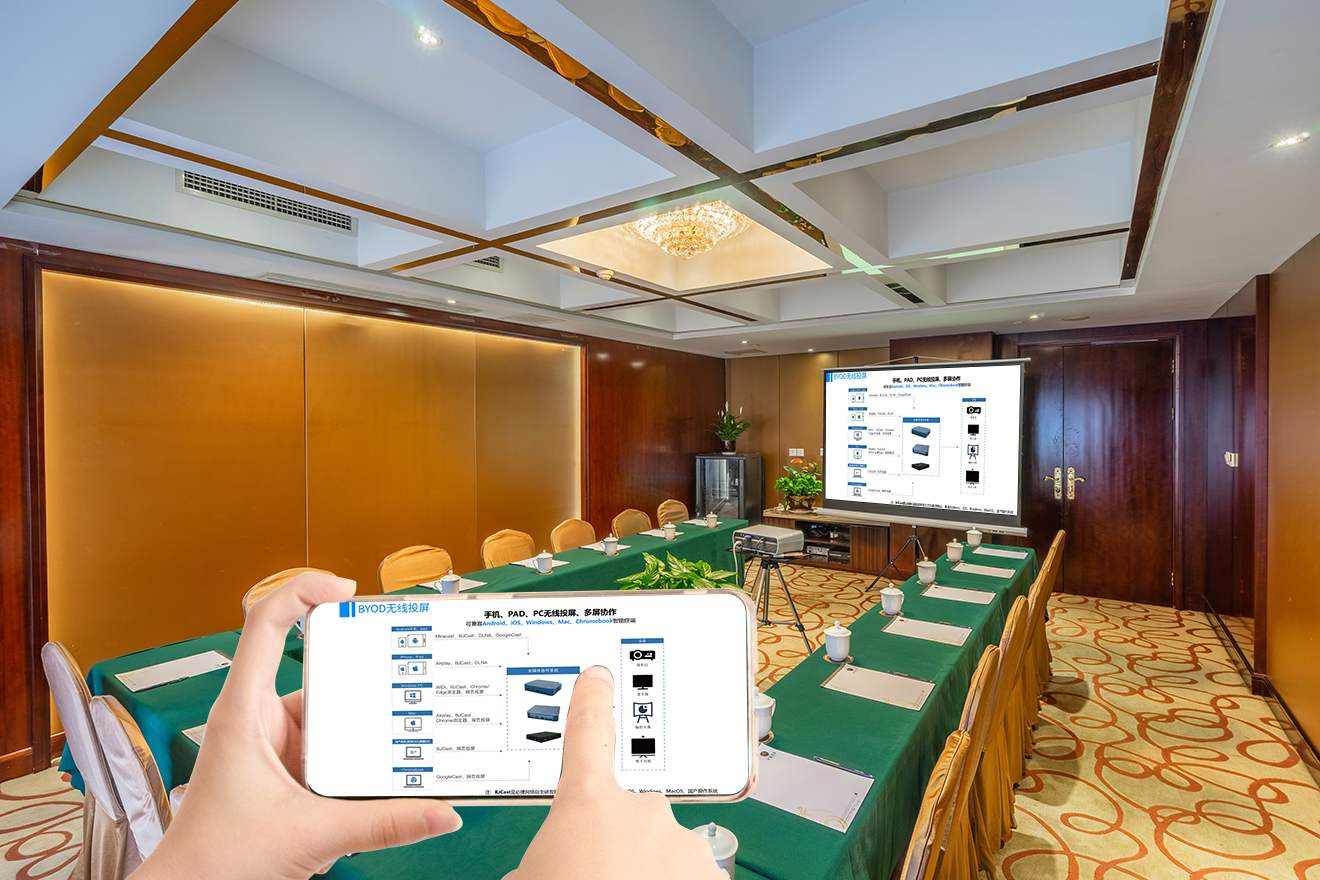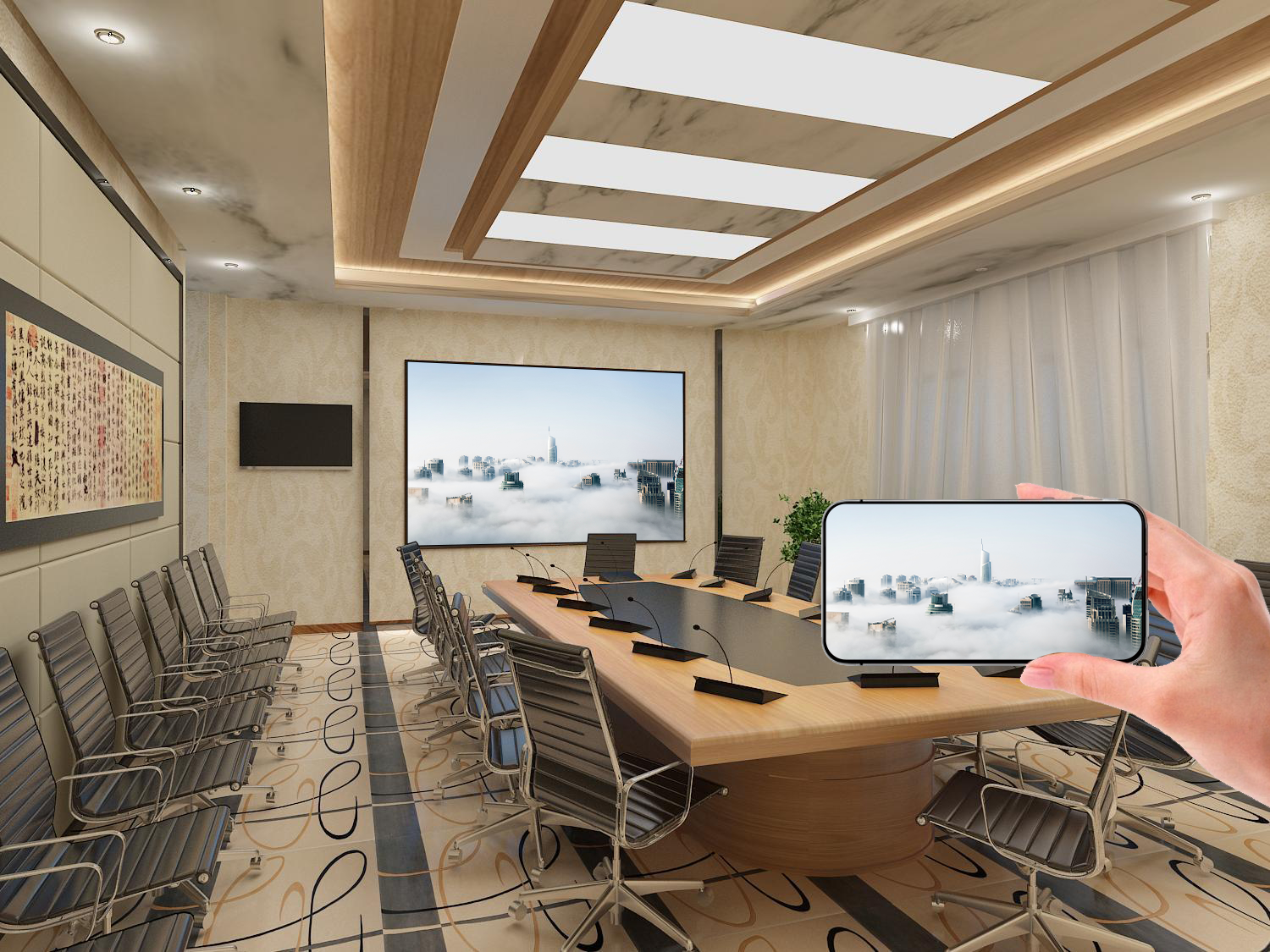Phone Screen Mirroring: An Efficient Interconnection Solution from Small Screen to Large Display
The phone screen mirroring solution addresses the pain points of connecting mobile devices to large displays. With its proprietary wireless transmission technology, it achieves fast connections, high-definition transmission, and two-way interaction between a phone and various display terminals. Covering all scenarios—from office, education, and meetings to home use—it allows content from your phone to be displayed efficiently on a large screen, unlocking the convenient value of mobile office and learning.
Core Technology Highlights
- Deep Adaptation for All Models: It is compatible with all system phones, including iOS, Android, and HarmonyOS, without needing to install a dedicated app. It directly uses the system’s native mirroring functions (e.g., Apple’s “Screen Mirroring” and Android’s “Wireless Display”). For older models, Bijie’s QR code mirroring technology ensures compatibility, with a phone adaptation rate of 99.9%, solving the interconnection problem for phones of different brands and versions.
- High-Definition, Low-Latency Transmission: It uses a dual-band Wi-Fi module and dynamic anti-interference algorithms to support 1080P Full HD quality transmission. Latency is controlled within 30ms, and the audio-visual synchronization error is <50ms. Even when a phone is running multiple tasks or in a complex network environment, the mirrored screen remains smooth and stable, meeting the needs for PPT presentations, video playback, and real-time data display.
- Diverse and Secure Connections: It provides three connection methods: “one-click mirroring, QR code mirroring, and NFC tap-to-connect,” completing pairing in 3 seconds. It supports device whitelisting, allowing only authorized phones to mirror. In sensitive scenarios, a “mirroring review” function can be enabled, where content must be confirmed by an administrator before it can be displayed. The transmission process uses AES-256 encryption to protect information security.
Key Function Design
- Two-Way Touch Interaction: The large screen can reverse-control the phone. In a meeting, you can directly turn pages of a proposal document or zoom in on image details on a touch screen. On the phone, you can remotely control the large screen’s volume and switch signal sources, freeing you from the restriction of “operating while standing in front of the device,” and increasing operational efficiency by 50%.
- Multi-Task Parallel Mirroring: It supports up to 4 phones mirroring simultaneously and displaying them in a split-screen view. The main screen can freely switch between single-screen and four-split layouts. In a class, the homework of multiple students can be compared simultaneously. In an exhibition, promotional videos for different products can be presented side-by-side, increasing information delivery efficiency by 60%.
- Real-Time Content Annotation: Mirrored content supports handwritten annotations. After a teacher mirrors courseware from their phone, they can annotate key knowledge points on the large screen, and the annotations are synchronized back to the phone. In a meeting, participants can use their phones to annotate revision suggestions, which are displayed on the main screen in real time, making collaborative interaction more intuitive.

Scenario-Based Implementation Solutions
(I) Mobile Office Scenarios
- Business Negotiations: A salesperson can quickly mirror a product video or a 3D model from their phone to a client’s large conference room screen. They can use the large screen’s reverse control to show details, and the client can annotate their requirements with a stylus, increasing communication efficiency by 40%. When paired with a Bijie meeting tablet, mirrored content can be integrated with whiteboard writing, allowing for immediate solution revisions.
- Ad-Hoc Meetings: In an open office area, you can mirror from a phone to a Bijie portable mirroring terminal. Team members can discuss a project timeline from the phone. It supports multiple people taking turns mirroring to add content, allowing a meeting to be advanced quickly without a computer connection, increasing decision speed by 30%.
(II) Smart Education Scenarios
- Classroom Interaction: A teacher can mirror an educational video from their phone to the classroom’s large screen and remotely control the playback progress from the phone. Students can film their problem-solving process and mirror it for display, and the teacher can annotate corrections on the large screen, increasing classroom participation by 70%. The Bijie teaching software supports the linkage between phone mirroring and a quiz system, which provides a real-time assessment of students’ understanding.
- Outdoor Study Tours: In a nature class, students can use their phones to film materials like plants and insects and mirror them to a portable projector. Groups can discuss the characteristics of the mirrored content. The teacher can push reference materials from their phone to the large screen, combining them with on-site observations to deepen the understanding of knowledge points and break the confines of the classroom.
(III) Home Entertainment Scenarios
- Audiovisual Sharing: You can mirror movies and shows from your phone to the TV. It supports 4K quality and Dolby sound effects. The phone can act as a remote to adjust the playback progress. The playback is not affected after the screen is turned off, providing an immersive experience comparable to a cinema. It supports switching mirroring between multiple phones, so family members can take turns sharing exciting content, making entertainment more interactive.
- Parent-Child Interaction: Parents can mirror educational videos for children from their phones to the TV and remotely control the playback, avoiding frequent contact with the large screen. When mirroring a family photo album, they can use the large screen to annotate and record the stories behind the photos, enhancing parent-child communication.
Management and Assurance System
- Centralized Device Management: Administrators can use the Bijie Cloud Platform to monitor the real-time operational status of mirroring terminals, phone connection records, and fault alarms. It supports remote firmware upgrades and parameter configurations, increasing batch maintenance efficiency by 80%.
- Data Statistics and Analysis: It automatically records data such as phone mirroring duration, content type, and device model, and generates analysis reports. Enterprises can use this to optimize their conference resource allocation, and schools can understand the frequency of use for their teaching devices, providing a basis for scenario optimization.
- Stable and Reliable Assurance: It uses an industrial-grade hardware design, supporting continuous operation for 7×24 hours, with an average time between failures (MTBF) of 50,000 hours. It is equipped with a wired backup port, which allows for a quick switch in case of a network failure, ensuring that critical scenarios are not interrupted.
The core of the phone screen mirroring solution is to make the phone an efficient link between the small and large screens. By using technology to eliminate device barriers and functional design to activate interactive value, it provides a stable, secure, and efficient mirroring experience for the convenient needs of mobile office and the interactive scenarios of smart education, redefining the standard for interconnection between mobile devices and large displays.